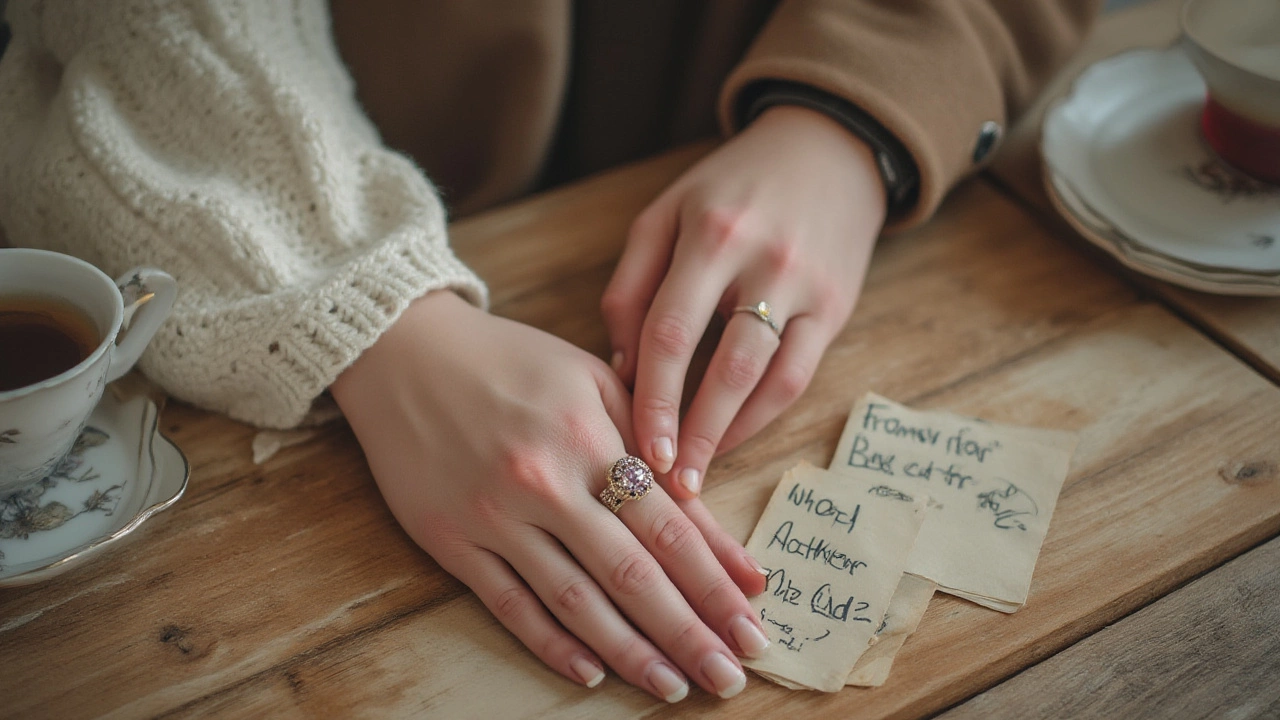Think about all the hands you’ve seen brandishing two dazzling rings after a wedding. For some folks, this just feels right, as natural as breathing. For others, the idea suddenly sparks confusion: do you really have to buy two rings when married, or is that just something movies want us to believe? Honestly, it’s one of those simple questions that turn complicated when tradition, trends, money, and personal taste twist together. The answers aren’t so black and white. You’ll find stories of people skipping one ring, two rings, or even stacking three for good measure. No one hands you an official rulebook, but plenty of opinions float around. Let’s dig in and clear up the confusion for good.
The Basics: Engagement Rings vs. Wedding Rings
Let’s strip this down to what matters. Traditionally, you’ll see two main types of rings during the marriage process: the engagement ring and the wedding ring (sometimes called a wedding band). Here in Ireland, most people still stick with two: the engagement ring is usually the one with the rock—the one someone proposes with—and the wedding ring gets exchanged during the ceremony. The engagement ring is all about the question, the wedding ring is about the answer.
Now, let’s not pretend everyone does it this way. For instance, in some Scandinavian countries, couples exchange similar bands when they get engaged and sometimes skip the “diamond” idea altogether. Some folks in Germany and Russia wear their rings on the right hand instead of the left. There are places (like parts of India) where toe rings symbolize marriage more than anything you’d put on your finger. So if your granny tells you it’s always been just one ring, she’s not wrong for her time or place—but things are a lot more flexible than wedding shop windows let on.
Not every proposal involves an engagement ring, especially if neither partner is into flashy jewelry. And there’s no magic law saying women must end up with a mini stack of precious metals as proof of love. Sometimes you’ll spot couples who just buy matching wedding bands. It’s less about what you “should” do, and more about what suits you and your partner. Clarifying what each ring means can save headaches later: one for the promise (engagement), one for actually getting married (wedding band). Whether you want both, just one, or an unconventional substitute, it’s all fair game these days.
Traditions and Trends: How Many Rings and Who Buys?
Here’s where things get spicy—tradition, society expectations, Insta-perfect diamonds, and practical considerations are all fighting for control. The “official” Western tradition says one partner (historically the man, but times change quickly) buys an engagement ring and surprises the other with a proposal. Later, both partners usually exchange wedding bands at the altar.
Stats from The Knot show that about 94% of engaged women in the US receive an engagement ring, with Ireland and the UK not far behind. Engagement rings average about €2,000 in Ireland (2024 numbers), but you’ll see everything from vintage bands under €400 to elaborate designer pieces over €10,000. Wedding bands are more practical—plain gold, silver or platinum, sometimes with small diamonds, running between €300 and €1,500 each. No wonder couples start asking: "Are two rings really necessary?" when you add up the total cost.
Let’s talk buying etiquette: traditionally, it’s still common for one person to purchase the engagement ring and both to buy their own wedding rings (or share the cost). But lots of modern couples split everything. Sometimes engagement rings become a team effort: shopping together, picking a setting, or even skipping the surprise part entirely for comfort’s sake. Don’t feel awkward if your story looks different. The best trends now are honesty and comfort—doing what fits, not what tradition dictates. That might look like two rings, one ring, or something else entirely.
- Engagement ring: traditionally given when proposing.
- Wedding ring: exchanged during the ceremony.
- Bands can be plain, diamond-studded, or customized.
- Some skip the engagement ring due to cost or preference.
- It’s increasingly common to pick out rings together.
Still, the dual ring tradition persists—fueled by wedding industry marketing and a genuine love for sparkly things. Rings create rituals and tangible memories, and many people enjoy keeping engagement and wedding rings separate, for symbolic (and practical) reasons.

What People Are Actually Doing: Real Couples, Real Choices
Walk into any wedding in Dublin, you’ll find every kind of ring story on show. My friends recently married at Merrion Square—she wore just her vintage sapphire engagement ring and opted for no band, while he wore a simple gold band. A neighbor picked matching platinum wedding bands with her husband: no engagement ring at all. Their reasoning? They liked the look, and frankly, spending that money on a trip to Barcelona felt way more special than any diamond.
Let’s get into why people decide on one, two, or even multiple rings. For some, it’s tradition—parents and grandparents did two rings, so it’s become sentimental. Others want both rings for practical reasons: the engagement ring (often decked with a raised gemstone) can be too delicate for daily wear, so they wear just the sturdier wedding band most days and add the engagement ring on special occasions. Some folks, especially those with hands-on jobs (nurses, chefs, mechanics), ditch the engagement ring outside of evenings out. If you’re worried about damage or loss, doubling up on a band can be a smart move.
And then there’s style. Some people love the “stacked ring” look—combining two (or even three) rings for a dramatic effect. Maybe you received an elaborate engagement ring and now want a minimal band to balance it. Or, maybe you want both rings to fit together seamlessly, like those “wedding sets” designed to nest together. It’s not unusual to see someone use a family heirloom as a wedding band, or even create totally custom rings from scratch. For LGBTQ+ couples, ring traditions often get remixed and personalized. The point is, there’s no universal right way—just what feels right to you.
- Some skip the engagement ring due to personal style or symbol preference.
- Others want both, maybe even a third anniversary ring later on.
- Work lifestyle, comfort, and family traditions factor into decisions.
- Stacking different styles and metals is popular—rules aren’t rigid.
- Heirloom rings and custom jewelry bring sentimental value.
There’s an actual benefit to these choices—not just in cost, but in how you craft your own marriage ritual. No one gets to tell you what’s meaningful but you. One charming stat from Brides magazine (2023) showed over 30% of couples now shop for rings together, and nearly 10% use only wedding bands with no engagement ring at all. That number’s up every year.
The Cost, Symbolism, and Practical Side of Buying Two Rings
Money talks, right? When you add up averages, buying both engagement and wedding rings can get pricey fast. Here’s a handy breakdown of what couples spend (Ireland, 2024):
| Item | Average Cost (€) | Range (€) |
|---|---|---|
| Engagement Ring | 2000 | 400 - 10,000+ |
| Wedding Ring (each) | 900 | 300 - 1,500+ |
So if you go the traditional two-ring route for both partners, you could be looking at €3,800 or more before anyone’s even said “I do.” Quite a few people are skipping the engagement ring now and investing extra cash in their honeymoon, a house deposit, or even a killer shared bike.
But it’s not just about the money. Engagement rings tend to symbolize the promise, the spark, that moment when “will you?” gets answered with “yes.” The wedding band stands for the lasting commitment, the day it all becomes official. This is why so many folks keep both—one speaks to the story’s beginning, the other its future. And if you’re sentimental, it’s hard to let go of either symbol.
But let’s get practical. Not every job, lifestyle, or preference lines up with wearing two rings. Some ergonomic bands are designed for comfort, or made from unusual materials (like titanium or silicone) if you’re outdoorsy or have sensitive skin. People who travel a lot or work with their hands tend to keep things simple. If your taste is minimalist, there’s barely any point in buying more than one if you won’t wear them both.
Before making any decisions, try rings on, see what feels good, and talk openly with your partner. It’s never worth stretching yourself financially to meet someone else’s vision. If you decide to buy two, you can often save money by getting wedding rings from small local jewelers or commissioning a custom design. And for anyone unsure, ask yourself: will you wear both, or just one most of the time? If it’ll sit in a drawer, maybe your money would be better spent somewhere else. Whatever you buy, make it mean something to you—that’s the only tradition that really matters.
